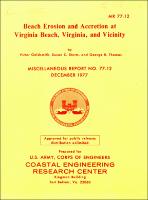Please use this identifier to cite or link to this item:
https://hdl.handle.net/11681/26309| Title: | Beach erosion and accretion at Virginia Beach, Virginia and vicinity |
| Authors: | Goldsmith, Victor Sturm, Susan C. Thomas, George R., 1946- |
| Keywords: | Beach erosion--Virginia--Virginia Beach Littoral drift--Virginia--Virginia Beach Sediments (Geology)--Virginia--Virginia Beach |
| Publisher: | Coastal Engineering Research Center (U.S.) |
| Series/Report no.: | Miscellaneous report (Coastal Engineering Research Center (U.S.));no. 77-12 |
| Abstract: | Eighteen profile lines from Fort Story south to the Virginia-North Carolina State line were surveyed monthly for 27 months (September 1974 to December 1976). Net volume changes were moderate, with maximum rates of accretion at the north and south ends of the study area. A statistical analysis using earlier surveys going back to November 1956 confirms the pattern of accretion in the north and south separated by erosion in the middle. Maximum annualized accretion rate during the 27-month study was 18.9 cubic meters per meter of beach front per year at profile line 1 (Fort Story), and maximum erosion rate 11.6 cubic meters per meter per year at profile line 9 (Sandbridge). The ridge-and-runnel morphology typical of many active shorelines was not observed in the study area. Under present conditions, rates of erosion and accretion are independent of the four types of shore usage defined for this study area (commercial, natural, military, and residential). The narrow, erosional beaches are located at the center of the study area in Back Bay National Wildlife Refuge (natural area), Dam Neck (military), and Sandbridge (residential); the wide, accretion beaches are located at the north and south ends of the study area in Fort Story (military) and False Cape State Park (natural). Instead of beach usage, it is suggested that the observed differences result from a nodal zone of diverging longshore transport in the middle of the study area (approximately Dam Neck to Back Bay). North of this zone, net transport is to the north, and south of this zone, it is hypothesized that net transport is to the south. The net, but irregular, movement of sediment out of the middle area explains the narrow, relatively inactive, erosional beaches observed in the middle and the wide, more active, accretion beaches observed on the ends. This interpretation supports existing bypassing and sand nourishment procedures which place sand at the south end of the Virginia Beach commercial reach for natural longshore processes to distribute to the north. The measured volume changes of beach sand in this reach, especially when compared with adjacent reaches, strongly indicate that the bypassing and nourishment procedures are needed for the maintenance of the Virginia Beach commercial beach area. Results of reconnaissance inspections of the shores of Currituck County, North Carolina, are included to better relate the Virginia Beach study area to the CERC Field Research Facility at Duck, North Carolina. |
| Description: | Miscellaneous Report |
| Rights: | Approved for public release; distribution is unlimited. |
| URI: | http://hdl.handle.net/11681/26309 |
| Appears in Collections: | Miscellaneous Report |
Files in This Item:
| File | Description | Size | Format | |
|---|---|---|---|---|
| CERC Miscellaneous Report No 77-12.pdf | 21.24 MB | Adobe PDF |  View/Open |